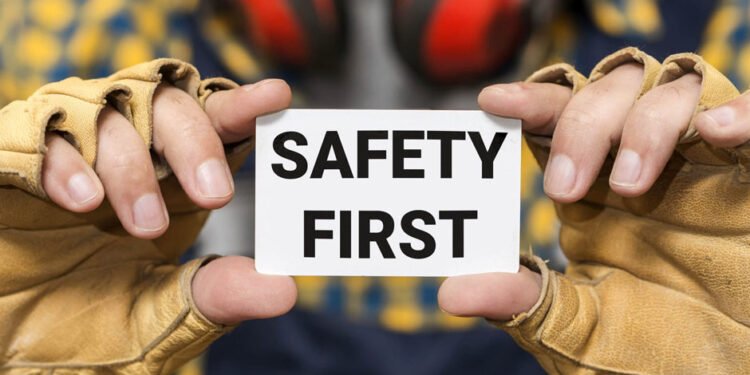Workplace accidents stink, don’t they? Someone gets hurt, work grinds to a halt, and no one is happy. But here’s the thing – with the right steps, many of these bummers can be avoided! In this handy guide, we’ll explore how employers and workers can team up to make the workplace safer. No boring legal jargon here, just straight facts on smart strategies to dodge accidents.
We’ll tackle important stuff like gear, training, speaking up about hazards, and more. When business owners and staff work together, they can create an environment that rocks – productive and accident-free! Safety rules aren’t lame, they’re a chance for everyone to thrive. Let’s get started and make your workplace a safer, happier place to be!
Understanding Employment Law Requirements for Workplace Safety
In the United States, workplace safety is governed by employment law, which sets legal requirements that employers must adhere to provide a safe work environment. These requirements are designed to protect employees from hazards and ensure their well-being. Resources like the employment law forum can help both employers and employees understand these legal obligations and how to apply them to contribute to a safer workplace.
By comprehending the standards set forth by employment law, businesses and staff can work together to implement the necessary policies, procedures, and precautions.
Employer Obligations:
Under US employment law, employers are legally obligated to take reasonable measures to ensure workplace safety. This includes identifying and eliminating hazards, providing proper training and supervision, and maintaining safety protocols. Employers should conduct regular inspections, address any safety concerns promptly, and implement corrective actions as necessary.
Employee Rights:
Employees have the right to a hazard-free workplace as provided by US employment law. They should be aware of their rights and responsibilities related to workplace safety. Employees have the right to report any safety concerns to their supervisors or designated safety representatives. They should also receive appropriate training and have access to safety information and resources.
To meet the legal requirements, employers and employees must collaborate and communicate effectively. This involves maintaining a culture of safety, where everyone is encouraged to identify and address potential hazards. By following employment law requirements for workplace safety, employers not only meet legal obligations but also create a positive work environment that promotes the well-being of their employees.
Conducting Regular Safety Assessments and Inspections
To maintain a safe work environment and prevent workplace accidents, employers must conduct regular safety assessments and inspections. By proactively identifying potential hazards and promptly addressing them, employers can mitigate risks and protect the well-being of their employees.
The Importance of Safety Assessments
Safety assessments involve a comprehensive evaluation of the workplace to identify any existing or potential hazards. This process allows employers to gain insight into the specific areas or practices that may pose a risk to employees’ safety. By regularly conducting safety assessments, employers can stay informed about any changes or developments that may impact the overall safety of the workplace.
During safety assessments, employers should focus on various aspects of workplace safety, including but not limited to:
- Physical hazards, such as faulty machinery or equipment, slip and trip hazards, and hazardous substances
- Ergonomic issues, such as inadequate workstation setup and repetitive motions
- Environmental factors, including air quality, noise levels, and lighting
- Emergency preparedness, such as evacuation plans, fire safety measures, and first-aid supplies
By thoroughly examining these areas and addressing any identified issues, employers can significantly reduce the risk of accidents and injuries in the workplace.
The Role of Workplace Inspections
Workplace inspections complement safety assessments by providing a detailed examination of specific areas or processes within the workplace. Inspections are typically conducted on a more frequent basis to ensure ongoing compliance with safety standards and to detect any potential hazards or deviations from established safety protocols.
When conducting workplace inspections, employers should:
- Thoroughly inspect all areas and equipment
- Check for any signs of wear and tear or damage
- Verify that safety devices and protective measures are in place and in good working condition
- Review employee compliance with safety procedures and protocols
Through regular workplace inspections, employers can identify and address potential hazards or non-compliance issues promptly. This proactive approach significantly contributes to accident prevention and ensures a safer work environment for all employees.
By prioritizing safety assessments and workplace inspections, employers show their dedication to maintaining a secure and healthy work environment. These practices help identify and mitigate hazards, preventing workplace accidents and promoting a culture of safety. Additionally, providing employees with protective gear, such as light adjusting safety glasses with prescription, further contributes to workplace safety, ensuring that employees are protected from both environmental risks and vision-related issues while performing their duties.
Developing Effective Safety Policies and Procedures
Developing comprehensive safety policies and procedures is crucial for accident prevention in the workplace. By creating clear guidelines and implementing these protocols, employers can ensure the safety and well-being of their employees while complying with US employment law.
The Importance of Safety Policies and Procedures
Safety policies serve as the foundation for a safe working environment. They outline the expectations and standards that employees must adhere to to prevent accidents and promote a culture of safety. These policies cover various aspects, including:
- Use of personal protective equipment (PPE)
- Proper handling and storage of hazardous materials
- Emergency response and evacuation procedures
- Safe operation of machinery and equipment
- Accident reporting and investigation processes
By establishing safety procedures, employers provide their employees with clear instructions on how to perform their tasks safely, reducing the risk of injuries or accidents in the workplace.
Training Employees on Safety Policies and Procedures
Developing effective safety policies and procedures is only the first step. It is essential to ensure that employees are trained on these guidelines to properly implement them in their daily work routines. Training programs should cover:
- The specific safety policies and procedures relevant to their job roles
- Proper usage of safety equipment and tools
- Recognizing potential hazards and taking necessary preventive measures
- Responding to emergencies and following evacuation protocols
Regular training sessions, workshops, and informational materials can reinforce these policies and procedures, empowering employees to actively participate in maintaining a safe work environment. Employers should also provide refresher training to ensure that all employees stay up to date with any changes or updates to the safety protocols.
Enforcing Safety Protocols
Enforcement of safety policies and procedures is crucial for their effectiveness. Employers must consistently monitor and enforce compliance with these protocols to minimize workplace accidents. This includes:
- Conducting regular inspections to identify any non-compliance or potential hazards
- Providing feedback and corrective action when necessary
- Rewarding employees who consistently follow safety protocols
- Implementing disciplinary measures for repeated violations
By creating a culture of accountability and prioritizing safety, employers can foster an environment where all employees understand the importance of adhering to established safety policies and procedures.
Developing effective safety policies and procedures requires a collaborative effort between employers and employees. By working together to establish, train, and enforce these protocols, workplaces can maintain a safer environment for all.
Promoting Employee Training and Awareness Programs
Creating a safe work environment starts with promoting employee training and awareness programs that focus on accident prevention. Proper training equips employees with the knowledge and skills they need to navigate potential hazards, use equipment safely, and respond to emergencies effectively.
By investing in employee training, employers demonstrate their commitment to their workers’ well-being and comply with safety regulations set by employment law in the US. Training empowers employees to recognize and mitigate risks, fostering a culture of safety in the workplace.
The Benefits of Employee Training
Implementing comprehensive training programs brings numerous advantages in accident prevention:
- Enhanced Safety Awareness: Training increases employees’ awareness of potential dangers, helping them proactively identify and report hazards in their work environment.
- Reduced Accidents and Incidents: Through training, employees gain the necessary skills and knowledge to prevent accidents and minimize the likelihood of workplace incidents.
- Improved Emergency Preparedness: Training equips employees with the ability to respond swiftly and appropriately to emergencies, potentially saving lives and minimizing injuries.
- Increased Confidence and Well-being: Proper training instills confidence in employees, leading to improved morale, job satisfaction, and overall well-being.
Employers should tailor training programs to specific job roles and tasks, ensuring relevancy and effectiveness. Training sessions can incorporate a combination of hands-on exercises, classroom instruction, and interactive simulations to engage and educate employees effectively.
Regularly updating and reinforcing training programs is vital to accommodate changing industry standards, technologies, and safety regulations. This ensures that employees stay up-to-date with the latest safety practices and procedures.
In the next section, we will explore the importance of encouraging active employee involvement in safety initiatives as another essential strategy in accident prevention.
Encouraging Active Employee Involvement in Safety Initiatives
To effectively prevent workplace accidents, it is essential to foster a culture of safety that involves active participation from employees. By encouraging employee involvement in safety initiatives, organizations can create a robust framework for accident prevention and promote a safer work environment.
Establishing Safety Committees
One effective method of promoting employee involvement is establishing safety committees within the organization. These committees can consist of representatives from different departments who work together to identify and address safety concerns. By involving employees from various levels and areas of expertise, these committees ensure that safety initiatives are comprehensive and tailored to the organization’s specific needs.
Conducting Safety Drills
Regular safety drills are a valuable tool for enhancing employee involvement in accident prevention. By conducting drills that simulate various emergency scenarios, employees can practice their response skills and become more familiar with proper safety protocols. This hands-on experience not only improves employee preparedness but also reinforces the importance of safety in their daily work routines.
Encouraging Open Communication
Creating a culture of open communication is crucial for active employee involvement in safety initiatives. Organizations should encourage employees to report potential hazards, near misses, and safety concerns promptly. By establishing channels for anonymous reporting, employees can feel comfortable sharing information without fear of retribution, making it easier to identify and address safety issues before they lead to accidents.
By encouraging active employee involvement in safety initiatives through the establishment of safety committees, conducting regular safety drills, and promoting open communication, organizations can harness the collective knowledge and awareness of their workforce to prevent accidents.
Employee engagement in accident prevention not only improves safety outcomes but also cultivates a sense of shared responsibility and commitment to maintaining a safe and healthy work environment.
Reporting and Investigating Workplace Accidents and Near Misses
In compliance with US employment law, it is crucial for organizations to establish a robust system for accident reporting and conducting thorough workplace investigations. Prompt reporting of accidents and near misses is essential to ensure the safety of employees and prevent future incidents. By implementing effective investigation procedures, employers can identify the root causes of accidents and take appropriate corrective actions to mitigate risks.
The Importance of Accident Reporting
- Accidents and near misses must be reported promptly to enable the necessary measures to be taken to prevent their recurrence.
- Reporting accidents helps identify trends and patterns, enabling organizations to identify areas where improvement is needed.
- Accurate accident reporting ensures compliance with legal requirements and helps protect the rights and safety of employees.
Conducting Thorough Workplace Investigations
- Thorough investigations aim to identify the root causes and contribute to developing effective preventive measures.
- Investigations should be conducted by competent individuals who are knowledgeable about safety protocols and legal requirements.
- Employers should gather evidence, interview witnesses, and analyze data to determine the causes and contributing factors of the accident.
- It is essential to document investigation findings, recommendations, and any actions taken to prevent future accidents.
Implementing Corrective Actions
- Once the investigation is complete, employers should implement corrective actions based on the findings and recommendations.
- Corrective actions may include revising policies, improving training programs, modifying equipment or procedures, or addressing any identified deficiencies in the workplace.
- Regular follow-up and monitoring are necessary to ensure the effectiveness of corrective actions and to prevent the recurrence of accidents.
By prioritizing accident reporting and conducting thorough investigations, organizations can create a safer work environment for their employees. It is essential to foster a culture that encourages all employees to promptly report accidents and near misses and actively participate in the investigation process. Compliance with US employment law regarding accident reporting and investigations not only safeguards employees but also helps organizations achieve better overall safety outcomes.
Conclusion
In conclusion, this article has provided essential strategies for employers and employees to prevent workplace accidents under US employment law. By understanding and complying with legal requirements, conducting regular assessments, developing safety policies, promoting training and awareness, encouraging employee involvement, and properly reporting accidents, both employers and employees can contribute to creating a safer work environment.












